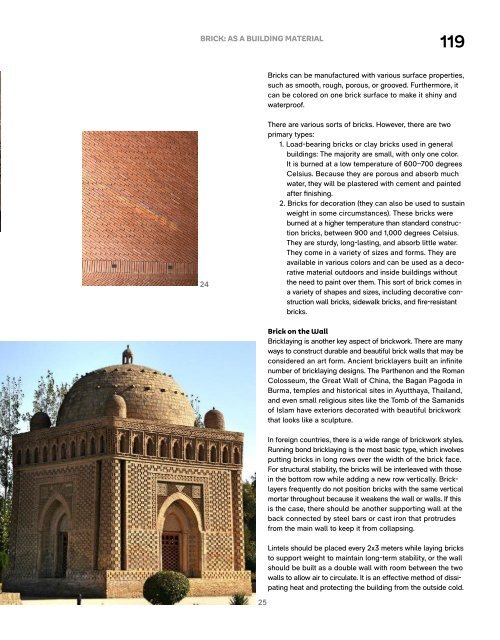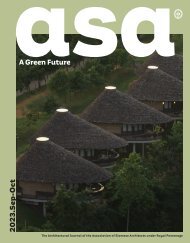ASA Journal 16/2023
Create successful ePaper yourself
Turn your PDF publications into a flip-book with our unique Google optimized e-Paper software.
BRICK: AS A BUILDING MATERIAL<br />
119<br />
Bricks can be manufactured with various surface properties,<br />
such as smooth, rough, porous, or grooved. Furthermore, it<br />
can be colored on one brick surface to make it shiny and<br />
waterproof.<br />
24<br />
There are various sorts of bricks. However, there are two<br />
primary types:<br />
1. Load-bearing bricks or clay bricks used in general<br />
buildings: The majority are small, with only one color.<br />
It is burned at a low temperature of 600–700 degrees<br />
Celsius. Because they are porous and absorb much<br />
water, they will be plastered with cement and painted<br />
after finishing.<br />
2. Bricks for decoration (they can also be used to sustain<br />
weight in some circumstances). These bricks were<br />
burned at a higher temperature than standard construction<br />
bricks, between 900 and 1,000 degrees Celsius.<br />
They are sturdy, long-lasting, and absorb little water.<br />
They come in a variety of sizes and forms. They are<br />
available in various colors and can be used as a decorative<br />
material outdoors and inside buildings without<br />
the need to paint over them. This sort of brick comes in<br />
a variety of shapes and sizes, including decorative construction<br />
wall bricks, sidewalk bricks, and fire-resistant<br />
bricks.<br />
25<br />
Brick on the Wall<br />
Bricklaying is another key aspect of brickwork. There are many<br />
ways to construct durable and beautiful brick walls that may be<br />
considered an art form. Ancient bricklayers built an infinite<br />
number of bricklaying designs. The Parthenon and the Roman<br />
Colosseum, the Great Wall of China, the Bagan Pagoda in<br />
Burma, temples and historical sites in Ayutthaya, Thailand,<br />
and even small religious sites like the Tomb of the Samanids<br />
of Islam have exteriors decorated with beautiful brickwork<br />
that looks like a sculpture.<br />
In foreign countries, there is a wide range of brickwork styles.<br />
Running bond bricklaying is the most basic type, which involves<br />
putting bricks in long rows over the width of the brick face.<br />
For structural stability, the bricks will be interleaved with those<br />
in the bottom row while adding a new row vertically. Bricklayers<br />
frequently do not position bricks with the same vertical<br />
mortar throughout because it weakens the wall or walls. If this<br />
is the case, there should be another supporting wall at the<br />
back connected by steel bars or cast iron that protrudes<br />
from the main wall to keep it from collapsing.<br />
Lintels should be placed every 2x3 meters while laying bricks<br />
to support weight to maintain long-term stability, or the wall<br />
should be built as a double wall with room between the two<br />
walls to allow air to circulate. It is an effective method of dissipating<br />
heat and protecting the building from the outside cold.

















